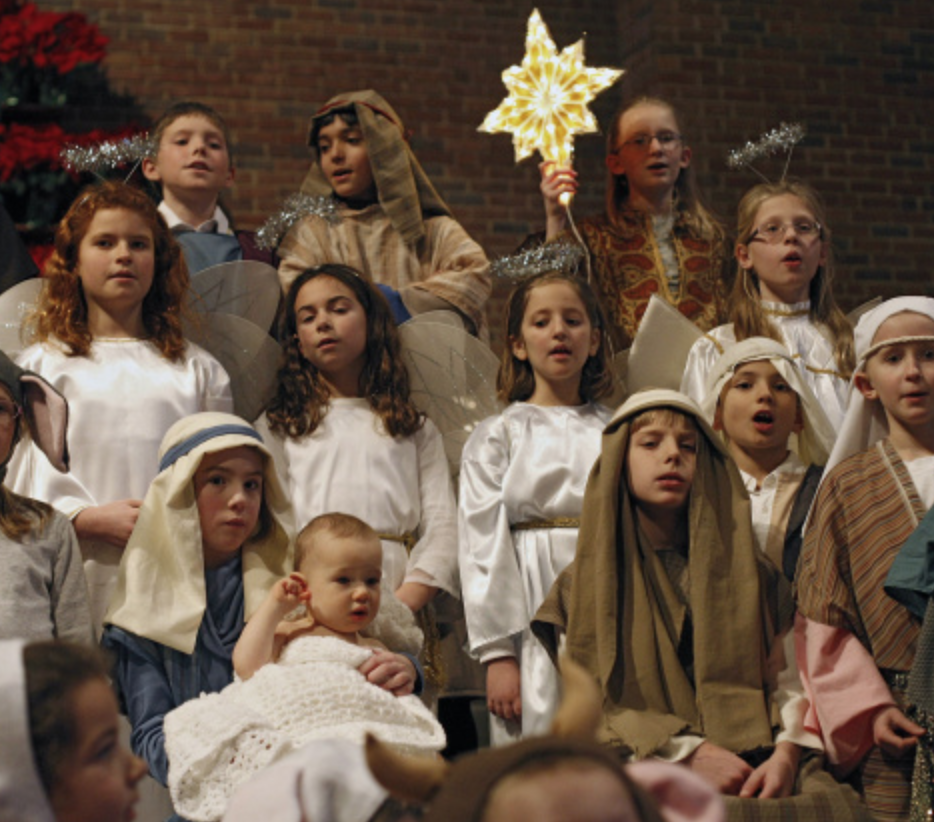How to hold a Children’s Christmas Pageant today

Question & Answer
Stephen from Westmere, Australia writes:
Question:
If, as you say, the stories of Jesus’ miraculous birth are pious legends, what are the implications for staging a children’s Christmas pageant in a small suburban church?
Answer: Rev. Gretta Vosper

Ah, the Christmas pageant! A delightful opportunity for intergenerational engagement that shares a story of magic and wonder. Its appeal is rooted in our own wistful memories and we love to see children caught up in the same exuberance as we once felt, lo, those many years ago.
Often, the story brought to life includes the three wise men (sic) and shepherds, crowded together in the small stable. Angels hover on the sidelines and baby lambs and donkeys provide opportunity for costume variety. The congregation’s youngest child or a substitute doll (we once used my daughter’s black Cabbage Patch doll), lies in a manger. We can see it all. But perhaps the most dramatic part of the story displayed when all are in their places – a challenge for stage managers dealing with excited, and often unruly children – is how wrong it all is.
Not only is the central story of the virgin birth a myth, there was no inn (and no surly innkeeper), no stable, no animals. The shepherds and the magi were nowhere near each other in the gospel accounts, the latter showing up at a house, not a stable, at a considerably later date. Even the shining star which rises in Matthew’s story, is not associated at all with Jesus’ birth, but only with the (likely Zoroastrian) magi who noticed its rise, and, so the story goes, followed it to find him and offer their gifts.
While there may have been animals in close proximity to a manger (there is no mention of them in the gospels), if your pageant has them talking at the stroke of midnight, the virgin nodding to the little drummer boy so he can play a solo for the smiling baby Jesus, or three majestic Kings with gifts, you are tragically deep in the magical thinking that has fed the Christmas story for two thousand years.
What to do? The story of Jesus’ birth seems so central to the Christian narrative that we feel compelled to tell it even when we know it isn’t true. But this can be deeply problematic, particularly when we are entertaining members of the public who are very likely not in attendance when the story is deconstructed with contemporary (and not so contemporary), critical scholarship in bible studies or sermon series. We live in a time when the once crucial distinctions that religions provided us are no longer helpful. Our recognizable differences – the food we eat, the clothes we wear, the symbols we drape and tattoo on our bodies – once sheltered us safely amongst those who were like us. But now, armed as we are with twenty-first century weaponry, religious intolerances can quickly turn deadly. Even when religion is not the reason for war and violence, it is often the fuel used to stoke political, economic, and civil tensions. We can no longer afford to fire the imagination with beliefs that privilege one group of humans over another.
The Christmas story, then, must be told as myth so that all who witness it in pageant form, go away with smiles on their faces knowing that it is not a story of privilege or power, but a story that invites us to explore our own lives in the light of the possibilities into which each human being is born. Well, maybe that’s a bit deep for audiences laughing until they cry when the angel trying to see his wings twirls so fast in pursuit of them that he collapses in the hay from dizziness. Perhaps the best we can do is be clear that the story is a myth and let the questions percolate.
Living the Questions created a pageant called “Matt and Lucy’s Version Births” in which two children were given directorial responsibilities, each provided a different gospel narrative from which to work. That is sure to raise questions for both participants and audiences. But it is important to acknowledge that there are answers to many of the questions raised and they need to be shared. Be prepared to provide some of them, perhaps even in a question and answer form in a handout you can distribute as the audience disperses. “Was Jesus really born in a stable? Not likely. …”
Or, if you don’t want to tamper with the cultural accretions that make up some of the cuter pageant possibilities, at least be honest about the story itself. In addition to a simple handout, you can begin the wonder in the opening moments of the pageant, situating this story amongst the fabled tales we’ve shared throughout our history. Begin it with the simple but telling words, “Once upon a time ….”
~ Rev. Gretta Vosper
This Q&A was originally published on Progressing Spirit – As a member of this online community, you’ll receive insightful weekly essays, access to all of the essay archives (including all of Bishop John Shelby Spong), and answers to your questions in our free weekly Q&A. Click here to see free sample essays.
About the Author
The Rev. Gretta Vosper is a United Church of Canada minister who is an atheist. Her best-selling books include With or Without God: Why The Way We Live is More Important Than What We Believe, and Amen: What Prayer Can Mean in a World Beyond Belief. She has also published three books of poetry and prayers.
